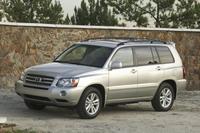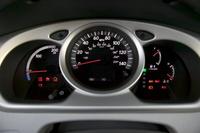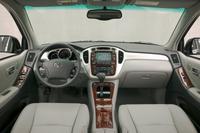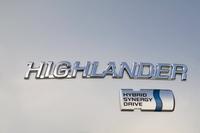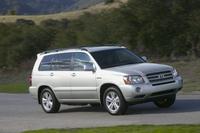2006 Toyota Highlander Hybrid 4x2 Review
DRIVING DOWN THE ROAD
With Carey Russ
2006 Toyota Highlander Hybrid 4x2
While the usefulness of an SUV may be hard to question, the fuel consumption of most such vehicles is very questionable, especially in light of current fuel costs. So what could be more appropriate than a usefully-sized hybrid SUV?
Toyota's hybrid SUV starts with its popular mid-size Highlander and adds the latest development in the ``Hybrid Synergy Drive'' system developed in the Prius sedan. The Highlander Hybrid gives up nothing to its gasoline-only relative in useful space, with even a standard third-row folding bench seat, and has a standard towing capacity of 3,500 lbs. It's offered in front-wheel drive form, or with a four-wheel drive system that uses an electric motor instead of internal-combustion power to drive the rear wheels when needed.
Like the Prius, the Highlander Hybrid is a full hybrid, capable of running on purely gasoline power, purely electric power, or any combination of the two. Its 3.3-liter V6 engine is closely-related to the one in the regular Highlander, but is tuned differently because of its use in the Hybrid Synergy Drive system. Unlike the regular Highlander, the Hybrid's alternator, power steering pump, water pump, and air conditioning compressor are not driven by belts off the engine, as the gas engine is designed to shut down when it is not required. But when the engine is turned off, electric power must be generated, the power steering must be operable, coolant must circulate, and the air conditioning may have to work. So the alternator is replaced by a motor-generator (motor-generator 1, aka MG1), and the other components are electrically-driven. This not only allows comfortable operation in fully-electric mode, it reduces noise and improves fuel economy.
Electricity is stored in a 288-volt nickel metal-hydride (NiMH) battery pack under the second-row seat, in otherwise-unused space. That power is boosted to 650 volts and then inverted to AC to run the 123-kilowatt front traction motor, motor-generator 2 (MG2). MG1 acts as the starter motor and also as a generator to recharge the battery pack. It also, by regulating the amount of power it generates, controls the output speed of the transaxle through a planetary gear-set similar to those found in automatic transmissions, effectively operating a continuously-variable transmission (CVT). Four-wheel drive models have a third motor-generator, which drives the rear wheels. It also can recharge the battery pack when braking or coasting.
If that sounds complicated, it is. But it's almost completely unnoticeable in operation, and the Highlander Hybrid is an exceptionally smooth and quiet vehicle. From the driver's standpoint, it works like a regular car - the batteries and motors require no extra maintenance, just fill the gas tank, check the oil and tires, and go.
Two grades are offered, standard and Limited. Standard is as well-equipped as a regular V6 Highlander, and the Limited adds enough luxury features and amenities to be competitive with some offerings from luxury brands. Both are available in front- or four-wheel drive form.
I've just spent an interesting week with a standard-model front-wheel drive Highlander Hybrid. If the regular Highlander correctly read the intentions of the suburban-utility vehicle buyer - and it did, being the best-selling midsize car-based SUV - the Hybrid takes the genre solidly into the 21st Century. Yes, there are premiums in price and weight, but Toyota's hybrid system works, and works well. The Highlander Hybrid combines the utility of a midsize SUV with excellent power when it's needed, and quiet, economical operation.
APPEARANCE: How to tell a Hybrid from a regular Highlander: There is a small opening in the front bumper of the Hybrid. There is a small ``Hybrid Synergy Drive'' on the tailgate. And perhaps the standard wheels are different, but there are enough wheel choices from Toyota and the aftermarket that wheels are not a good spotting feature. It is the Highlander least likely to be found in a gas station.
COMFORT: The reason to buy an SUV like the Highlander is space and versatility, and those are two reasons for the Highlander's success. The Hybrid in no way detracts - the hybrid drive-train fits in the engine compartment, and the battery pack fits neatly under the second-row seat. OK, perhaps a few mostly-unusable cubic feet of space under that seat have disappeared, maybe, but when was the last time you put anything large and/or important in such a position? In standard trim, it's much like a mid-level Camry, with comfortably-padded synthetic-upholstered seats. The driver's seat is power-adjustable, while the front passenger's is manual, and the second row seat has ample space for real humans, and is split 60/40 not only to fold flat for cargo but to recline a bit and be adjustable fore and aft. The third row, in common with all such in midsize SUVs, is best used for people under 5' 4" and will hold two. The most notable difference from the regular Highlander is found in the Hybrid's instrument panel, which is a bright ``Optitron'' display that has a kilowatt meter in place of the tachometer. Because of the Hybrid Synergy Drive system, a tach is pointless, and the kW meter can be useful in attempting high mileage - just try to keep it as near zero as possible.
SAFETY: Being a Toyota SUV, the Highlander Hybrid has the Star Safety System, which includes Vehicle Stability Control (VSC), traction control, antilock brakes with electronic brake-force distribution, and Brake Assist. It also has the Vehicle Dynamics Integrated Management system (VDIM), which preemptively reacts to loss of vehicle control.
RIDE AND HANDLING: Like its gasoline-only stablemate, the Highlander Hybrid is a middle-of-the-road, middle-class uni-body crossover SUV related to Toyota's ever-popular Camry sedan. It's no stretch to refer to to a Highlander as a Camry wagon, although it's actually slightly shorter than the current Camry, and higher. Trucks are not in its background, and it rides, feels, and drives like a car. It does sit a little higher, a plus for driver visibility and poor-road and snow clearance if a minus for absolute cornering power. But absolute cornering power is not the reason to buy a Highlander. Like all Highlanders, the Hybrid has a fully-independent MacPherson strut-type suspension, tuned for comfort but capable of good handling for a 4,000-lb. vehicle. Good soundproofing and the hybrid drive-train contribute to a quieter than average ride experience.
PERFORMANCE: There is no reason a hybrid can't have quick acceleration. The power characteristics of an internal combustion engine and electric motor complement each other well. The engine runs most efficiently and develops the most power at medium to high revolutions, while the motor develops maximum torque as soon as it starts to rotate. Useful statistics here: The Highlander Hybrid's engine makes 208 horsepower at 5600 rpm, with maximum torque 212 lb-ft at 4400 rpm. The motor makes 167 horsepower at 4500 rpm, with 247 lb-ft of torque from zero to 1500 rpm. The mix of power from each varies, and can be best told by looking at the display at the bottom of the speedometer. Only when the motor comes in when extra power is needed at highway speeds is is apparent that there is something different about the Hybrid, and then it feels like a moderate turbo boost. At low speeds, the engine assists the motor; at higher speeds the motor assists the engine. The vehicle operates electrically more than the last Prius I drove, and is in that mode most of the time under light throttle at low and medium speeds. Operating electrically, with the engine shut off, it's very quiet, but the engine is so quiet that it can be hard to hear even when it is running. Other than the quiet, and the lack of discrete shifting from the electronically-controlled CVT transmission, there is nothing really different about driving the Highlander Hybrid. Except maybe fewer stops for gasoline.
In the week I had the Hybrid, I came nowhere near emptying the tank, and the standard model doesn't have a mileage readout, so I can only estimate mileage. Figure it's closer to the EPA figures that was the case with earlier hybrids as it does operate electrically more. So at approximately 28 to 30 mpg overall, it compares favorably with the V6 Highlander, which gets around 20 mpg.
CONCLUSIONS: With the Highlander Hybrid, Toyota pushes the gasoline-electric hybrid vehicle ever closer to the mainstream of modern automotive technology.
SPECIFICATIONS
2006 Toyota Highlander Hybrid 4x2 SUV
Base Price $ 33,030
Price As Tested $ 36,382
Engine Type dual overhead cam 24-valve aluminum alloy V6
Engine Size 3.3 liters / 201 cu. in.
Horsepower 208 @
5600 rpm
Torque (lb-ft) 212 @ 4400 rpm
Electric
motor 650 VAC permanent magnet
Horsepower 167 @ 4500
Torque 247 @ 0-1500 rpm
Transmission
electronically-controlled continuously-variable
Wheelbase /
Length 106.9 in. / 185.6 in.
Curb Weight 4,070 lbs.
Pounds Per Horsepower n/a
Fuel Capacity 17.2 gal.
Fuel Requirement 87 or 91 octane unleaded gasoline
Tires
225/65 SR17 Michelin Energy XSE
Brakes, front/rear vented disc
/ solid disc,
antilock standard
Suspension, front/rear
independent MacPherson strut /
independent MacPherson strut
Drivetrain front engine, front-wheel drive
PERFORMANCE
EPA Fuel Economy - miles per gallon
city / highway / observed 33 / 28 / 30
0 to 60 mph 7.6 sec (est)
OPTIONS AND CHARGES
Package #1 - includes:
foglamps, color-keyed rear spoiler, urethane steering wheel with audio controls, JBL premium AM/FM/cassette/6-disc in-dash CD changer power tilt & slide moonroof $ 1,770 Carpet and cargo mat set $ 199 VIP RS3200 security system $ 359 Stainless steel tube steps $ 459 Destination $ 565



